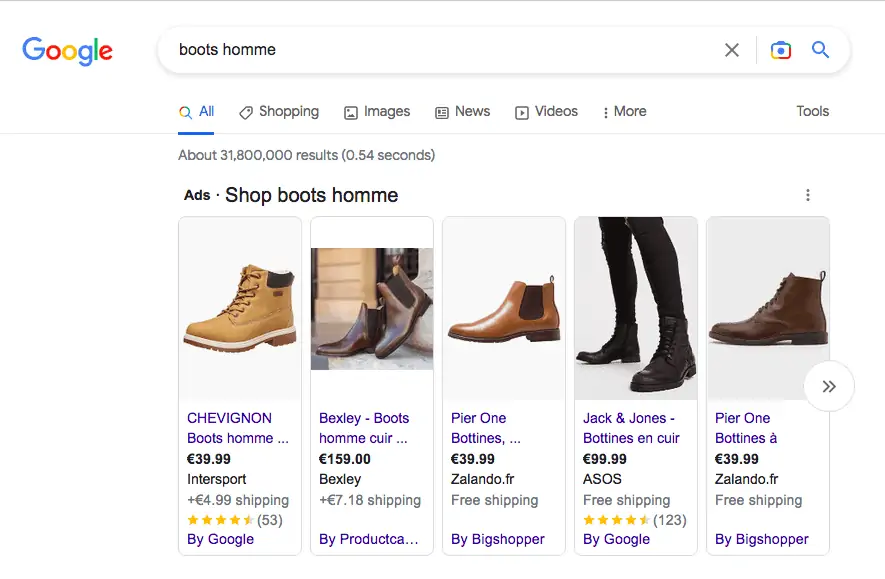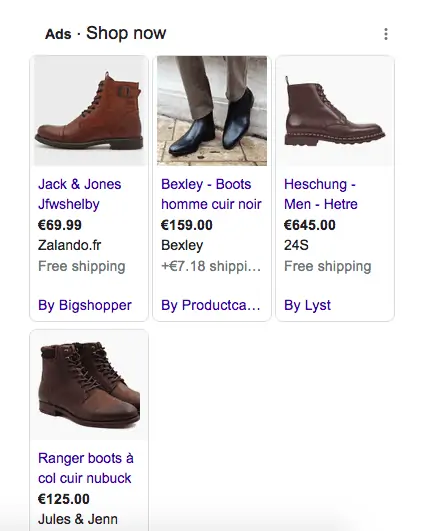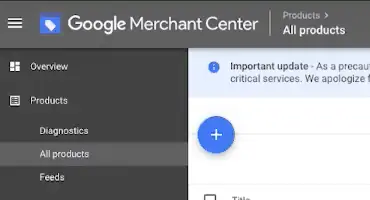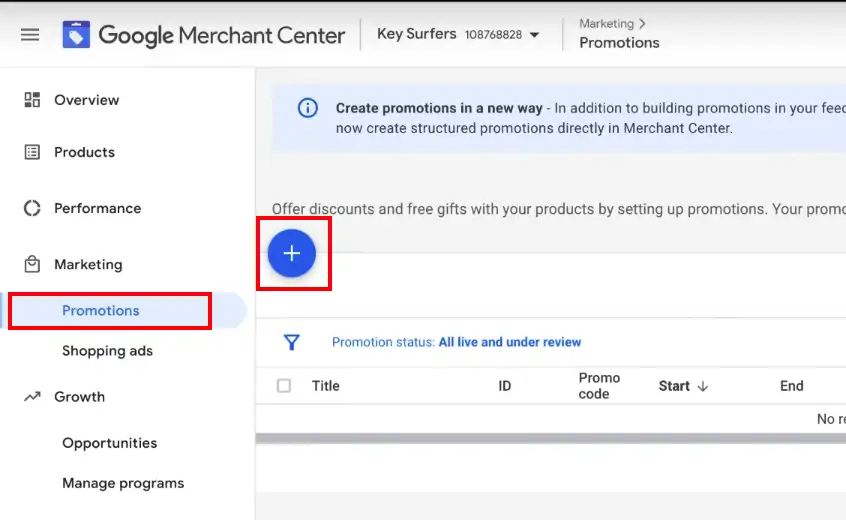How to optimize Google Shopping ads?
Google Shopping is a Google Ads program that allows businesses to put their products on sale in Google search results.
By using Google Shopping, your products can appear in front of the right people at the right time. This means you don’t waste money on ads that don’t perform well.
Want to increase your sales? Want to increase traffic to your website? Then you need to optimize your Google Shopping ads.
Good news, that’s exactly what we’re going to see in this article.
- A great use of Google shopping ads can be a powerful way to increase traffic and conversions for your online store.
- A good ads optimization begins with a good product feed.
- It’s important to monitor your ads performance to adapt your strategy.
What are Google shopping Ads?
Google Shopping Ads are Google AdWords ads that appear in Google search results when people are looking for products to buy. Google Shopping ads include:
- an image of the product,
- the price,
- the store name,
- and other information about the product.
You’ve certainly seen it before. It looks like this:


As you can imagine, using Google Shopping has many benefits. Let’s take a look at the main ones.
Why is it important to optimize your ads?
Optimizing your ads is very important because they:
- are a great way to improve your visibility on Google.
- can automate your product listings, which saves you time and energy.
- tend to perform better than other types of Google Ads ads, so you’re likely to see better results for your eCommerce business.
- can help you benchmark your competition and see how they’re priced their products.
- can also improve your SEO by helping you get more traffic from Google.
- And finally, can be integrated with Google Shopping to track your ad performance and ROI.
That being said, let’s take a look at how to improve your Google Shopping ads for the best results.
9 amazing tips to optimize Google Shopping Ads
As you have seen, it is very important to work seriously on the optimization of your ads to get good results, but how?
Here are 9 tips to succeed in your Google Shopping campaigns:
- Use Google Merchant Center to upload your product data.
- Optimize your product titles and descriptions.
- Use high-quality images.
- Create a unique selling proposition.
- Bid on the right keywords: insert the keyword you target in the title and in the description to help the algotirhm to understand what your products are about
- Fill everything you can in the Google Merchant Center: return conditions, delivery fees, delivery delays, logos, validated phone number, business address, automatic optimization of the images, …
- Use Google Shopping promotions: easy to increase visibility with a promotion tag
- Monitor your campaign performance.
- A/B test your ads
Let’s see each of these tips in detail! Don’t miss the surprise at the end.
1. Use Google Merchant Center to upload your product data
The first step to optimizing your Google Shopping ads is to upload your product feed to Google Merchant Center. It’s a free service that allows you to upload your product information, such as:
- product titles,
- descriptions,
- prices,
- and photos.
To get started, create a Google Merchant Center account and follow the instructions to set up your account. Once you’ve registered and verified your website, you can start uploading your product feed.
To upload your product data:
- go to the Google Merchant Center dashboard and click on the Products tab.
- From there, you can add your product information using the “Add a product” button.

2. Optimize your product title and description
Once you’ve uploaded your product data to Google Merchant Center, the next step is to work on the optimization of your product titles and descriptions. This is important because your title and description are what show up in Google Shopping search results.
To improve your titles and descriptions you have to:
- Use relevant keywords: Include relevant keywords in your titles and descriptions so that people can find your products when they’re searching for them on Google.
- Keep it short and sweet: Don’t stuff your titles and descriptions with too many keywords. Keep them short and to the point.
- Write for your audience: Write titles using relevant keywords that describe your products. For example, if you sell women’s clothing, you might want to use words such as “women’s clothing,” “ladies’ clothes,” or “women’s fashion.”
3. Use high-quality images
Another important factor in optimizing your product feed is using high-quality images. Your product image is what people will see when they’re looking at your ad, so it’s important to make a good impression.
Here are a few tips for creating high-quality product images:
- Use clear, sharp photos: Blurry or low-quality photos will make your products look unprofessional.
- Use white backgrounds: Google Shopping ads typically have white backgrounds, so it’s best to use white backgrounds for your product images as well. This will allow your products to stand out from the rest.
- Use high-resolution images: Google requires product photos to be at least 100×100 pixels. But it’s best to use images that are even higher resolution, so that they look sharp on retina displays.
4. Create a unique selling proposition
One way to make your Google Shopping ads campaigns more effective is to create a unique selling proposition (USP). A USP is a statement that describes what makes your products or services better than the competition.
Creating a USP will help you stand out from the competition and attract more customers. Here are a few tips for creating an effective USP:
- Keep it short: You want people to be able to understand it quickly and easily.
- Focus on the benefits of your products or services, rather than the features: For example, if you sell organic food, your USP might be “healthy and delicious foods that are good for you.”
- Be specific: Don’t just say that your products are “the best.” Tell people exactly why they’re the best.
5. Bid on the right keywords
You don’t specify keywords in a Google Shopping campaign. The algorithm will bid on search intents depending on the understanding it has about your products, essentially through the title and the description.
You must carefully choose the right keyword to target in your products feed.
Here are a few tips for bidding the right keywords:
- Use keyword research tools: There are a number of great keyword research tools out there, such as Google Ads Keyword Planner and Google Trends. These tools can help you find the right keywords for your products.
- Think like the algorithm: insert the main keyword in the title, insert the secondary keywords in your description
- Think like your customer: be catchy if you can. Be different from your competitors but don’t forget to the second point (think like an algorithm too).
6. Fill everything you can in the Google Merchant Center
You must fill all the informations available. It’s more informations for the users. And Google loves when you follow his rules.
- Return conditions: they are an essential trigger to buy on a shop.
- Delivery fees: they are an essential trigger to buy on a shop.
- Delivery delays: I think you already know: they are an essential trigger to buy on a shop.
- Logos: show your brand. It’s awareness!
- Business informations: validate your phone number and fill all the business informations. It will show Google you are a legit business.
- Automatic optimization: Google can automatically improve some of the content you provide. It’s better to use it.
7. Use Google Shopping Promotions
Google Shopping Promotions are a great way to attract customers and boost sales. They allow you to offer discounts on your products, which can be a great incentive for people to buy from you.
To set up a Google Shopping Promotion:
- go to the “Promotions” tab and click on “Create a new promotion.“

- From there, you’ll be able to select the type of promotion you want to create, as well as the discount amount. Google Shopping Promotions can be either percentage-based or fixed-price discounts.
8. Monitor your campaign performance
It’s important to monitor your Google Shopping campaign performance on a regular basis. This will help you see what’s working and what’s not, so you can make changes as needed.
There are a few things you should look at when monitoring your campaign performance:
- Click-through rate (CTR): This is the number of times your ad is clicked divided by the number of times it’s shown. A high CTR means that your ad is relevant and interesting to your target audience.
- Conversion rate: This is the number of people who buy your product divided by the number of people who click on your ad. A high conversion rate means that your ad is effective at driving sales.
- Average order value (AOV): This is the amount of money that people spend when they purchase your product. A high AOV means that your product is in demand and that people are willing to spend a lot of money on it.
If you need further assistance monitoring your campaigns or targeting new leads, don’t hesitate to reach out to a Google Ads agency for help.
9. A/B test your ads
A/B testing is a great way to test different versions of your Google Shopping ad to see which one performs the best. To do this, you’ll need to create two or more versions of your ad, with each version slightly different from the others. You can then run each version of your ad for a period of time and see which one performs the best.
When A/B testing your ads, there are a few things you should keep in mind:
- Test one thing at a time: When you’re A/B testing your ad, it’s important to only change one thing at a time. This will help you isolate the effect that each change has on your ad’s performance.
- Test multiple times: A/B testing is not a one-time thing. You should perform multiple tests, with each test addressing different aspects of your ad.
- Be patient: Don’t expect to see results from your A/B tests immediately. It can take time to gather enough data to see which version of your ad is performing the best.
The surprise! The 10th tip!
Don’t forget the Google Free Listing: it’s free and visible in the Google Shopping tab.
10. Don’t forget the Google Free Listing
Google Free Listing is currently the best shopping opportunity. In 2021, Google release a free shopping listing, like it was at the very first beginning of this program.
The main benefits: it’s free. It’s very visible in the Shopping tab.
To be part of this program: you must have a shopping feed in the Google Merchant Account and fill all the mandatory fields about your business. Once you have, your products will automatically be visible in the Shopping tab.
How it works: it’s not easy to explain how it works. It’s a mix of SEO and SEA. SEA because it uses your shopping feed. So, if you have optimised your feed, it will have an impact in your ranking. SEO because it seems to use some onsite data, like rich snippets for the price, the category, …
How to improve your visibility: We don’t have a secret to be in a front row all the time. We compare, we search, we analyse, but it’s not easy. Stay tuned on Debugbar.com because there will be more news on this topic in next months.
Optimizing your Google Shopping Ads in a nutshell…
To sum it up, optimizing your Google Shopping ads campaigns is very important to ensure that your products are visible to potential customers, while also reducing your advertising costs and improving your ROI. So, make sure to optimize your ads 😉
- A successful ads optimization starts with a well organized product feed (title, description, image, product category…).
- Using the right keywords is essential to appear in relevant searches.